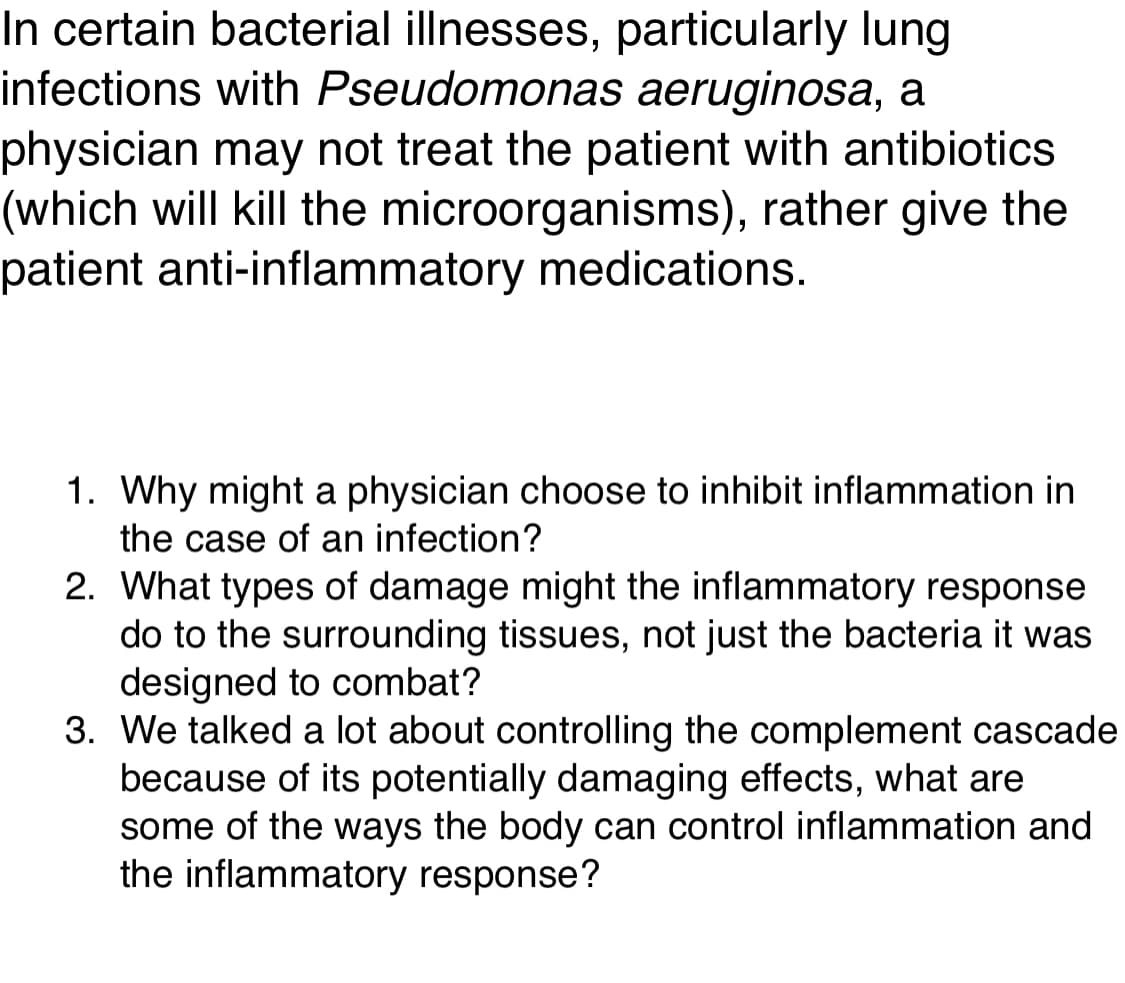In certain bacterial illnesses, particularly lung infections with Pseudomonas aeruginosa, a physician may not treat the patient with antibiotics (which will kill the microorganisms), rather give the patient anti-inflammatory medications. 1. Why might a physician choose to inhibit inflammation in the case of an infection? 2. What types of damage might the inflammatory response do to the surrounding tissues, not just the bacteria it was designed to combat? 3. We talked a lot about controlling the complement cascade because of its potentially damaging effects, what are some of the ways the body can control inflammation and the inflammatory response?
In certain bacterial illnesses, particularly lung infections with Pseudomonas aeruginosa, a physician may not treat the patient with antibiotics (which will kill the microorganisms), rather give the patient anti-inflammatory medications. 1. Why might a physician choose to inhibit inflammation in the case of an infection? 2. What types of damage might the inflammatory response do to the surrounding tissues, not just the bacteria it was designed to combat? 3. We talked a lot about controlling the complement cascade because of its potentially damaging effects, what are some of the ways the body can control inflammation and the inflammatory response?
Microbiology for Surgical Technologists (MindTap Course List)
2nd Edition
ISBN:9781111306663
Author:Margaret Rodriguez, Paul Price
Publisher:Margaret Rodriguez, Paul Price
Chapter9: Microbial Disease Transmission
Section: Chapter Questions
Problem 1UTM: As an illustration, a patient undergoing a laparoscopic-assisted vaginal hysterectomy (LAVH)...
Related questions
Question
100%

Transcribed Image Text:In certain bacterial illnesses, particularly lung
infections with Pseudomonas aeruginosa, a
physician may not treat the patient with antibiotics
(which will kill the microorganisms), rather give the
patient anti-inflammatory medications.
1. Why might a physician choose to inhibit inflammation in
the case of an infection?
2. What types of damage might the inflammatory response
do to the surrounding tissues, not just the bacteria it was
designed to combat?
3. We talked a lot about controlling the complement cascade
because of its potentially damaging effects, what are
some of the ways the body can control inflammation and
the inflammatory response?
Expert Solution
This question has been solved!
Explore an expertly crafted, step-by-step solution for a thorough understanding of key concepts.
Step by step
Solved in 4 steps

Recommended textbooks for you

Microbiology for Surgical Technologists (MindTap …
Biology
ISBN:
9781111306663
Author:
Margaret Rodriguez, Paul Price
Publisher:
Cengage Learning

Human Physiology: From Cells to Systems (MindTap …
Biology
ISBN:
9781285866932
Author:
Lauralee Sherwood
Publisher:
Cengage Learning

Microbiology for Surgical Technologists (MindTap …
Biology
ISBN:
9781111306663
Author:
Margaret Rodriguez, Paul Price
Publisher:
Cengage Learning

Human Physiology: From Cells to Systems (MindTap …
Biology
ISBN:
9781285866932
Author:
Lauralee Sherwood
Publisher:
Cengage Learning